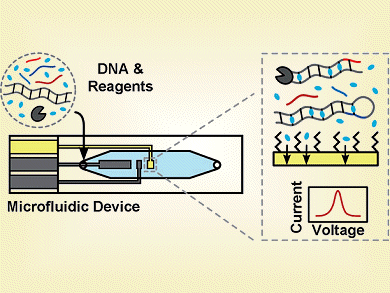Portable and Fast Method of Detection
Our ability to detect pathogens has become quite good, but it usually requires complex laboratory techniques. Sometimes we need a quick result, or there is no laboratory nearby. Portable and fast methods of detection that are also sensitive, reliable, quantitative, and effective over a broad range of concentrations are thus highly desirable. In the journal Angewandte Chemie, American researchers have now introduced a new approach for a lab-on-chip technique for the detection of pathogens by means of their genetic material. The method is so sensitive that it was able to detect as few as 16 copies of DNA from salmonella—in less than an hour.
Since the introduction of the polymerase chain reaction (PCR)—which has become the primary method for the duplication of genetic material—into clinical diagnosis, the detection of many pathogens has become significantly more reliable and sensitive. However, even PCR requires a great deal of equipment and time, involving bulky apparatus, precisely maintained temperature cycles, and successive addition of reagents. All of this demands a certain expertise from the operator.
A team led by Kuangwen Hsieh and H. Tom Soh at the University of California, Santa Barbara, USA, chose to use a newer alternative to PCR, loop-mediated isothermal amplification, abbreviated as LAMP. This method is very fast, sensitive, and selective for the desired pathogen. It requires no temperature cycles upon addition of reagents. The team combined LAMP with electrochemical detection by means of a microfluidic chip to make MEQ-LAMP, microfluidic electrochemical quantitative LAMP.
Quantifying the Pathogen’s Concentration
In a tiny chamber on the chip, enzymes generate copies of the DNA contained in the sample. Six different primers, single-stranded fragments of the target DNA with a start sequence for the enzymes, act as the starting point. Methylene blue, a dye that lodges in DNA strands, serves as the electrochemical detection reagent. At first, most of the methylene blue molecules are free in the solution and come into contact with electrodes that are mounted in the chamber. When a cyclic voltage is applied, redox reactions between the electrode and the methylene blue produce a current. The more copies of the DNA that are produced, the more methylene blue is lodged in the strands, making it unavailable to the electrodes, thus causing the current to decrease. This goes faster when more pathogenic DNA strands are contained in the sample. The time at which the current signal is at its maximum can be determined so accurately that the researchers can use it to quantify the concentration of pathogen.
A future chip could support multiple chambers for the parallel detection of different pathogens. This could then be used as a prototype for the development of effective rapid tests for point-of-care diagnosis, food safety, environmental monitoring, and the fight against biological weapons.
Image: © Wiley-VCH
- Rapid, Sensitive, and Quantitative Detection of Pathogenic DNA at the Point of Care through Microfluidic Electrochemical Quantitative Loop-Mediated Isothermal Amplification,
K. Hsieh, A. S. Patterson, B. S. Ferguson, K. W. Plaxco, H. T. Soh,
Angew. Chem. Int. Ed. 2012.
DOI: 10.1002/anie.201109115





The portable and fast method of detection is very convenient for rapid diagnostic